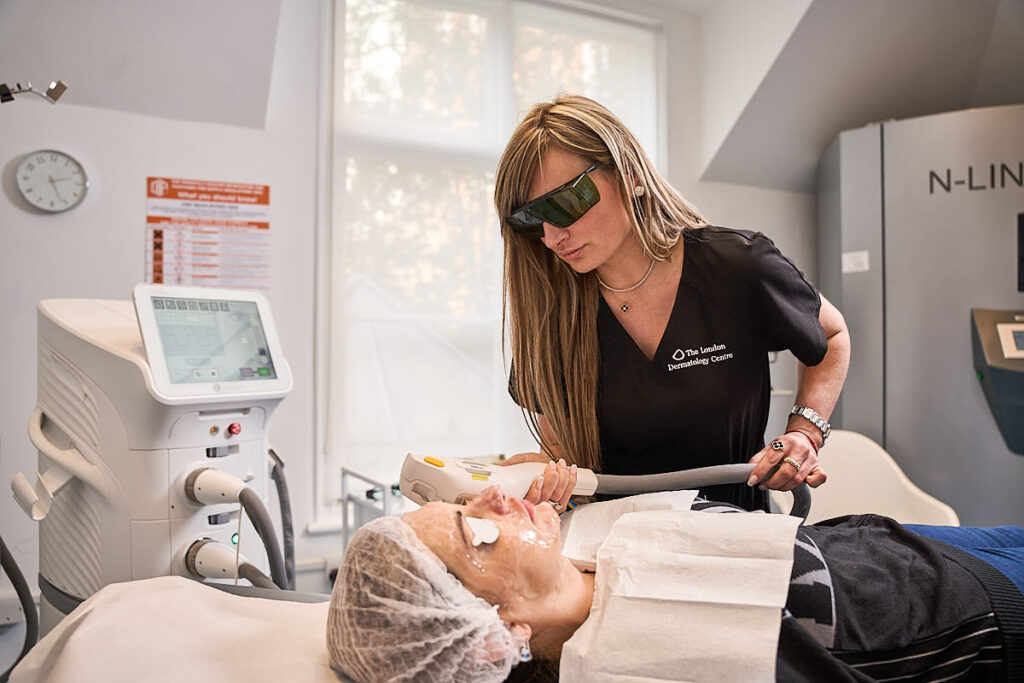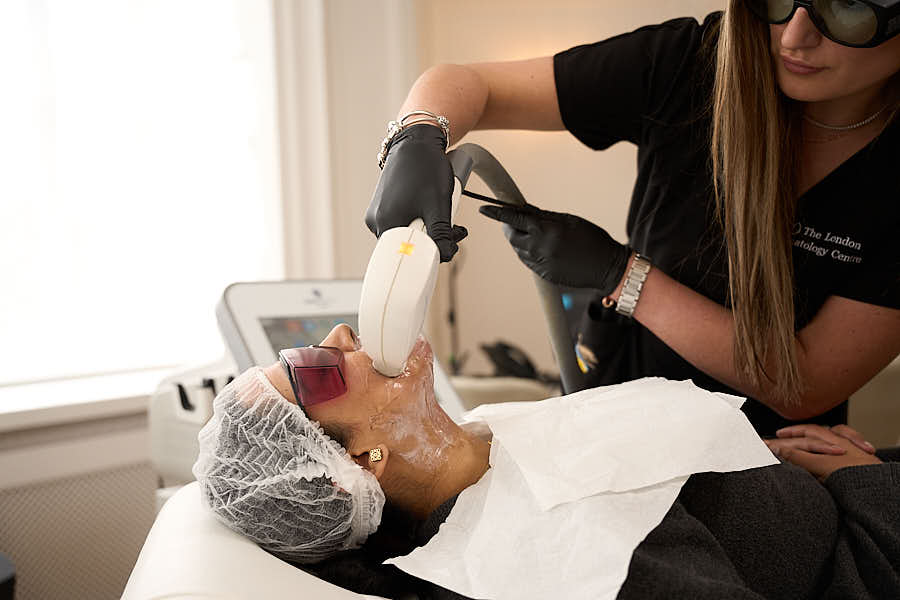Birthmarks are common skin anomalies that can vary widely in appearance, from light brown patches to prominent red vascular marks. While many birthmarks are harmless, some individuals seek treatment for cosmetic reasons or due to complications such as ulceration, bleeding, or psychological distress. Laser therapy has become the most widely researched and used method for non-invasive birthmark removal.
Over the past decade, advancements in laser technology have greatly improved outcomes—particularly for vascular and pigmented birthmarks. This article explores the types of lasers used, how they work, and what current clinical research reveals about their effectiveness and safety.
Understanding Vascular vs Pigmented Birthmarks
Before diving into laser treatment options, it’s important to distinguish between vascular and pigmented birthmarks. Vascular birthmarks, such as port-wine stains, haemangiomas, and salmon patches, arise from abnormal blood vessels under the skin. These often appear red, purple, or pink.
Pigmented birthmarks, on the other hand, are caused by clusters of melanocytes and appear as brown, black, or bluish lesions—examples include café-au-lait spots, congenital melanocytic naevi, and Mongolian spots. The type of birthmark significantly influences the choice of laser treatment, as vascular lesions respond to different wavelengths and pulse durations than pigmented ones.
Pulsed Dye Lasers: The Gold Standard for Vascular Birthmarks
The pulsed dye laser (PDL) is widely regarded as the first-line treatment for many vascular birthmarks, especially port-wine stains. Operating at a wavelength of around 585–595 nm, PDL targets oxyhaemoglobin in blood vessels, causing selective photothermolysis—essentially heating and destroying the abnormal vessels without harming surrounding tissue.
Recent studies have shown that early intervention in infants with PDL can result in better clearance with fewer sessions. A 2023 clinical review in Lasers in Surgery and Medicine reported that over 70% of patients with port-wine stains experienced significant fading after multiple PDL sessions, particularly when started before the age of one. Side effects are generally mild, such as temporary bruising or discolouration, and the risk of scarring is low.
Q-Switched Lasers for Pigmented Lesions
For pigmented birthmarks, Q-switched lasers are among the most effective tools. These lasers emit high-intensity pulses in extremely short durations (nanoseconds), which are ideal for targeting melanin-rich lesions.
Depending on the pigmentation depth and type, different wavelengths are used—1064 nm for deeper dermal lesions, and 532 nm for more superficial ones. Clinical trials have demonstrated the effectiveness of Q-switched Nd:YAG lasers in treating café-au-lait macules, with a clearance rate of around 60–75% after several treatments.
However, recurrence remains an issue, particularly for congenital lesions. Researchers are now exploring whether combining Q-switched lasers with fractional technology or topical agents may improve long-term results. Hypopigmentation and hyperpigmentation are potential side effects, especially in individuals with darker skin tones, so careful skin typing and patch testing are essential before treatment.
Fractional Lasers: A Promising Adjunct
Fractional lasers, both ablative and non-ablative, create microthermal zones in the skin, promoting controlled dermal injury and subsequent collagen remodelling. While they are primarily used for scar revision and skin resurfacing, recent studies have highlighted their potential in treating resistant birthmarks—particularly those that do not respond fully to PDL or Q-switched lasers alone.
A 2022 study published in Dermatologic Therapy found that fractional CO2 lasers, when combined with PDL, improved port-wine stain clearance in adult patients by enhancing laser penetration and vascular targeting. Fractional technology is also being trialled in treating dermal melanocytosis and large congenital melanocytic naevi, where pigment is deeply embedded. Though still an emerging application, fractional lasers may play an important role in multimodal treatment plans in the near future.

Combining Modalities for Enhanced Results
As laser technology continues to advance, clinicians are increasingly combining different types of lasers to improve outcomes, especially for mixed or treatment-resistant birthmarks. For example, PDL may be used in conjunction with Q-switched lasers to address both vascular and pigmented components in complex lesions. Some studies suggest that alternating sessions of Q-switched and fractional lasers can provide better pigment clearance while minimising side effects.
Moreover, pre-treatment with fractional lasers may enhance the absorption and effectiveness of pulsed dye energy in dense vascular lesions. Combination therapy must be tailored to the patient’s skin type, birthmark characteristics, and tolerance to downtime. While promising, further long-term studies are needed to assess the safety of repeated treatments and determine the ideal sequencing of laser types.
Treatment Timing: Why Earlier May Be Better
A growing body of evidence supports the notion that earlier laser intervention leads to better outcomes in birthmark treatment—particularly for vascular lesions. This is due in part to the smaller calibre of blood vessels in infants, which absorb laser energy more efficiently than larger, well-established vessels in older children or adults.
A 2021 study in Pediatric Dermatology concluded that starting PDL therapy before six months of age resulted in greater fading of port-wine stains with fewer sessions and reduced risk of adverse effects.
Additionally, early treatment may help minimise the psychosocial impact that visible birthmarks can have during childhood development. However, there are challenges with early intervention, such as the need for sedation or general anaesthesia in very young children, which carries its own risks. Paediatric dermatologists must weigh the benefits of early clearance against these procedural considerations on a case-by-case basis.
Anaesthesia and Pain Management During Laser Sessions
Pain management remains a significant aspect of laser therapy, particularly for children. While adults may tolerate the brief stinging sensation caused by laser pulses, young children—especially those undergoing repeated treatments—often require anaesthesia or sedation. Topical anaesthetics like lidocaine are commonly used for small treatment areas, but their efficacy can be limited for deeper or extensive lesions.
For larger or more sensitive birthmarks, such as those on the face or scalp, general anaesthesia is sometimes recommended, especially during early childhood. Cooling systems that deliver cryogen spray or contact cooling are now integrated into many modern laser devices to reduce discomfort and protect the skin.
Ongoing research is investigating less invasive analgesic options, including vibrating devices and virtual reality distraction methods, which have shown promise in paediatric pain management settings without the side effects of sedation.
Psychological Impact and the Role of Laser Treatment
The psychosocial burden of visible birthmarks, especially on the face or neck, should not be underestimated. Children and adults with conspicuous lesions often experience teasing, reduced self-confidence, and even social withdrawal. Laser treatment not only offers physical improvement but can have a profound effect on mental health and social well-being. In a 2020 qualitative study conducted in the UK, participants who underwent laser therapy for facial port-wine stains reported improved self-esteem, reduced anxiety, and greater social participation post-treatment.
For parents of children with visible birthmarks, early results from laser sessions often provide a sense of proactive care and reassurance. While treatment is not always curative, even partial fading can make a significant psychological difference. Dermatologists are increasingly encouraged to consider mental health outcomes alongside clinical results when discussing laser treatment plans with families.
Costs and Access to Laser Birthmark Removal

Access to laser birthmark removal varies significantly depending on geography, healthcare systems, and insurance policies. In the UK, for example, the NHS may cover laser treatment for birthmarks if they are symptomatic, disfiguring, or likely to cause psychological harm. However, coverage is often subject to clinical prioritisation and availability of specialised dermatology or laser clinics. In private settings, costs can be prohibitive, with multiple sessions required and prices ranging from £150 to £500 per treatment.
This disparity can lead to delays in care or exclusion from treatment altogether, particularly in underserved areas or among lower-income families. The need for equitable access has been highlighted in recent dermatology policy discussions, with calls for clearer clinical guidelines and increased NHS investment in laser equipment and trained professionals to ensure broader, fairer access to effective treatment.
Ethical Considerations and Parental Decision-Making
Treating birthmarks in infancy or early childhood raises important ethical considerations. While early laser treatment may yield better physical outcomes, some argue that non-urgent cosmetic procedures should be delayed until the child can participate in the decision. Parental motivation—whether driven by appearance-based concerns, social pressures, or genuine medical advice—must be explored carefully.
Ethical dermatology practice involves transparent discussion of the risks, benefits, and limitations of treatment, as well as consideration of the child’s future autonomy. Clinical guidelines increasingly recommend shared decision-making frameworks that include dermatologists, parents, and, when appropriate, child psychologists. Informed consent is essential, especially when general anaesthesia is involved.
As birthmark removal continues to advance technologically, the medical community must also ensure that ethical standards evolve in tandem to support patient-centred, compassionate care.
Advances in Imaging and Laser Precision
Recent innovations in imaging technology have significantly enhanced the precision of laser treatments for birthmarks. High-resolution dermoscopy, laser Doppler imaging, and optical coherence tomography (OCT) are now being used to assess lesion depth, blood flow, and pigment distribution before and during treatment. These tools allow clinicians to better understand the architecture of a birthmark and tailor laser parameters accordingly—reducing guesswork and improving outcomes.
For instance, using laser Doppler imaging, practitioners can identify areas of high vascular activity within port-wine stains, enabling focused treatment with the pulsed dye laser. Likewise, OCT helps evaluate the depth of pigmented lesions, guiding wavelength selection and pulse duration for Q-switched or fractional lasers.
A 2023 paper in Journal of Cutaneous and Aesthetic Surgery highlighted how integrating imaging into routine practice reduced the number of unnecessary sessions and improved patient satisfaction. These diagnostic adjuncts are particularly helpful when treating complex or mixed birthmarks with both vascular and pigmented features.
Laser Treatment for Rare or Complex Birthmarks
While pulsed dye and Q-switched lasers are well-studied for common birthmarks like port-wine stains and café-au-lait spots, there is growing interest in using lasers for rarer or more complex types. Conditions such as epidermal naevi, nevus of Ota, and phakomatosis pigmentovascularis pose unique challenges due to their depth, mixed composition, and resistance to traditional methods.
In such cases, combination laser therapy or long-term treatment protocols may be necessary. For example, the nevus of Ota—a deep dermal melanocytic lesion common in individuals of Asian descent—often responds best to the Q-switched 1064 nm Nd:YAG laser, although full clearance may require over ten sessions.
Case reports have also described successful outcomes when fractional lasers were used to improve skin texture and pigment distribution after initial clearance. These complex birthmarks highlight the need for long-term care plans and interdisciplinary input, including dermatology, ophthalmology, and occasionally plastic surgery.
Role of Genetics and Recurrence

Genetic factors play a crucial role in the development, persistence, and recurrence of certain birthmarks. Conditions such as congenital melanocytic naevi and capillary malformations have been linked to postzygotic mutations in genes like GNAQ, NRAS, and HRAS. These mutations may influence the response to laser therapy by affecting cell behaviour, pigment production, or vascular development. Research is ongoing into whether genetic profiling could help predict treatment outcomes or recurrence risk.
For example, a study in The British Journal of Dermatology (2022) found that port-wine stains with specific GNAQ mutations were more likely to recur or show resistance to pulsed dye laser treatment. Understanding these molecular underpinnings may eventually lead to personalised treatment plans, incorporating both laser therapy and pharmacological agents that target abnormal signalling pathways.
Genetic counselling may also be beneficial for families dealing with extensive or syndromic birthmarks, such as Sturge-Weber syndrome, where vascular lesions are part of a broader systemic condition.
Post-Treatment Care and Maintenance
Effective laser treatment doesn’t end when the session does—post-treatment care plays a critical role in recovery and results. After laser procedures, patients are typically advised to avoid sun exposure, apply cooling or soothing creams, and use high-factor sun protection to minimise pigment changes. In the days following treatment, mild swelling, redness, or bruising may occur, especially with PDL. For Q-switched and fractional lasers, there may also be crusting or temporary textural changes.
Adherence to post-laser protocols significantly reduces the risk of complications such as post-inflammatory hyperpigmentation, especially in patients with darker skin. Some practitioners also recommend short-term topical steroids to manage inflammation or antibiotics to prevent infection in high-risk areas.
As lasers become more widely used, patient education materials and follow-up appointments are becoming standard practice to support healing and monitor long-term effects. A structured aftercare plan ensures that patients gain the full benefits of treatment and maintain healthy, even-toned skin.
Public Awareness and Misconceptions
Despite the growing availability of laser treatments, public understanding of what they can—and cannot—achieve remains limited. Many people mistakenly believe that all birthmarks can be removed in a single session, or that laser treatment is risk-free. These misconceptions can lead to unrealistic expectations and disappointment. In reality, most birthmarks require multiple sessions for significant fading, and results can vary depending on factors like skin type, lesion size, and depth.
Some marks may only lighten rather than disappear completely. Public health campaigns and dermatologist-led education efforts are needed to provide accurate information about laser therapy, including expected timelines, potential side effects, and limitations.
With the rise of social media, visual results are frequently shared online—sometimes without context—further skewing public perception. Transparent communication between clinicians and patients, supported by evidence-based guidance, is essential for informed consent and long-term satisfaction with laser birthmark removal.
Innovations in Laser Technology and Customisation

The latest generation of laser devices now offers greater flexibility and customisation, enabling clinicians to tailor treatments with unprecedented precision. Innovations such as adjustable pulse durations, variable spot sizes, and dual-wavelength capabilities mean that a single platform can treat a wider range of birthmark types more effectively. For example, new-generation pulsed dye lasers can deliver both short and long pulses, allowing practitioners to switch settings mid-treatment depending on the lesion’s depth and response.
Similarly, the development of picosecond lasers—emitting even shorter pulses than Q-switched lasers—has shown promise in treating stubborn pigmented lesions with fewer side effects.
Some devices also include real-time skin feedback systems that measure skin impedance and temperature, automatically adjusting energy output for consistent, safe results. These technical advances not only improve efficacy but also enhance safety, reduce treatment times, and expand the range of skin types that can be treated safely—bringing the benefits of laser birthmark removal to a broader population.
The Importance of Specialist Care and Multidisciplinary Teams
Laser treatment for birthmarks is most effective when carried out in specialist centres with access to experienced dermatologists, trained laser operators, and multidisciplinary input. Particularly for complex or syndromic birthmarks, collaboration between dermatology, paediatrics, ophthalmology, neurology, and plastic surgery may be required. For instance, in conditions like Sturge-Weber syndrome or extensive congenital melanocytic naevi, laser therapy may form only one part of a broader treatment plan.
Specialist clinics are also more likely to have access to advanced equipment and can offer a tailored approach based on lesion type, location, and patient age. Furthermore, these centres typically have established protocols for sedation in young children, imaging for treatment planning, and long-term follow-up for assessing outcomes and managing recurrence.
As the demand for birthmark treatment grows, continued investment in training, equipment, and clinical research will be vital to ensure safe, ethical, and high-quality care across all patient groups.
Final Thoughts: The Evolving Landscape of Laser Birthmark Removal
Laser treatment for birthmarks has come a long way—from a once-limited cosmetic option to a clinically proven, highly customisable tool in modern dermatology. With pulsed dye lasers leading the way for vascular lesions, and Q-switched and fractional technologies expanding the possibilities for pigmented and complex birthmarks, patients now have access to safer and more effective options than ever before.
If you are looking for help in removing a birthmark, then you can contact us at The London Dermatology Centre for a consultation with one of our expert dermatologists who can guide you on the best approach.
Ongoing research, enhanced imaging, and innovations in laser engineering continue to refine outcomes, particularly when treatment begins early and is delivered by experienced, multidisciplinary teams. Yet it’s just as important to manage expectations, provide robust aftercare, and ensure ethical decision-making—especially when treating children.
As awareness grows and access improves, laser therapy offers not just aesthetic benefits, but real improvements in quality of life and psychological wellbeing. For many, it’s more than skin deep—it’s a path to greater confidence and comfort in their own skin. And with science driving continued progress, the future of birthmark treatment looks brighter than ever.
References:
- Alster, T.S. and Tanzi, E.L., 2003. Laser surgery of pigmented lesions and tattoos. Archives of Facial Plastic Surgery, 5(6), pp.460–463.
https://jamanetwork.com/journals/jamafacialplasticsurgery/fullarticle/480930 - Geronemus, R.G., 2000. High-fluence modified pulsed dye laser photocoagulation with dynamic cooling of port-wine stains in infancy: A preliminary study. Archives of Dermatology, 136(7), pp.942–943.
https://jamanetwork.com/journals/jamadermatology/fullarticle/480442 - Chapas, A.M., Eickhorst, K. and Geronemus, R.G., 2007. Efficacy of early treatment of facial port wine stains in newborns: A review of 49 cases. Lasers in Surgery and Medicine, 39(7), pp.563–568.
https://onlinelibrary.wiley.com/doi/abs/10.1002/lsm.20534 - Tan, W., Wang, G., Yang, H., Wang, J., Xu, L. and Zhu, X., 2012. Treatment of port-wine stains with the long-pulsed Nd:YAG laser. Photomedicine and Laser Surgery, 30(4), pp.228–232.
- Chen, J.K., Ghasri, P., Aguilar, G. and Kelly, K.M., 2012. An overview of laser treatment for vascular lesions: principles and recent developments. Journal of Clinical and Aesthetic Dermatology, 5(7), pp.31–44.
https://www.ncbi.nlm.nih.gov/pmc/articles/PMC3412272/
